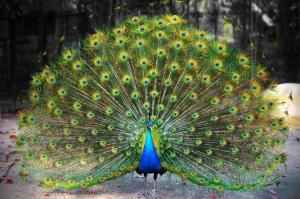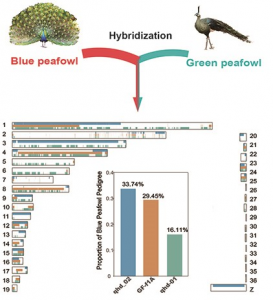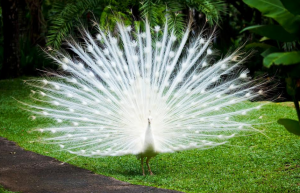Shades of blue and green
A new genomic analysis of the blue peafowl and its endangered green sister species provides insights into unwanted hybridization between these closely related birds, which may pose a risk to conservation efforts. The authors of a new GigaScience article also show that a mutation in one specific gene, EDNRB2, causes a unique white plumage variant of blue peafowl.
In Asia, the peafowl is a symbol of beauty, nobility, and good luck. However, one species, the green peafowl, may run out of luck if it doesn’t get more attention: The birds are endangered and face numerous threats including climate change, poaching, and habitat fragmentation. In order to protect this beautiful animal, China and Southeast Asian countries have initiated conservation programs and undertake efforts to stop poaching.

Blue peafowl. Photo: Wang et al., cc-by
In addition, a breeding program was established to release captive-bred green peafowls into their natural habitats, with the aim to enhance the genetic diversity of wild populations. However, the reintroduction plans also come with genetic risks and drawbacks, and that’s where the new GigaScience study and its genomic analyses come into play.
Fertile Hybrids
The green peafowl and its close relative, the blue peafowl, can actually cross-breed. Hybrid animals are fertile and can be further crossed or backcrossed with the ancestral species. As a result, hybrid offspring can be physically indistinguishable from the “pure” green species. And that’s a potential problem, as there’s a risk that captivity-bred hybrids are re-introduced into natural habitats, where they could hybridize further and alter the genetic make-up of endangered green peafowl populations.
The new data from Professor Lujiang Qu’s team at China Agricultural University helped to investigate the hybridization and introgression potential of blue and green peafowl in detail. First they assembled a new chromosome-level genome of the blue peafowl and improved the existing genome assembly of the green peafowl. They then collected data from 77 whole genomes, 76 mitochondrial genomes and 33 W chromosomes. Overall, they found substantial genetic evidence for recent hybridizations between “green” and “blue”.

Evidence for Hybridization. Fig from Wang et al. (CC-BY)
The authors emphasize:
“Releasing individuals without confirming their genetic status contributes to genetic contamination, hastening the extinction of pure green peafowl.”
Standards for animal release are needed
Globally standardized protocols to prepare green peafowls for release, both within zoos and animal protection organizations, are currently lacking. The authors urge governments and conservation agencies to establish policies that prevent the release of hybridized birds.
“Furthermore, it is crucial to prioritize the identification of purebred individuals during releases of other endangered species, ensuring that conservation efforts are rooted in scientific knowledge and expertise.”, they add.
In addition to the hybridization problem, the authors also looked into other interesting signals in the genomic data, among them a peculiar trait within the blue peafowl population. Already back in 1868, Charles Darwin wrote about white peafowl varieties with black eyes – indicating that they are not albinos (albinos have red eyes due to the lack of melanin). Rather , they are “leucistic” varieties, which are able to produce melanin but lack pigmentation cells in the plumage. Professor Lujiang Qu and his team, including Gang Wang and Liping Ban from China Agricultural University, were specifically interested in a beautiful white variety called “pied peafowl”.
One small mutation, big effect

white peafowl. Photo: Wang et al. cc-by
Based on genomic and transcriptomic data the authors identified a nonsense mutation in a gene called EDNRB2 as the causative mutation for the leucistic plumage in this variety – a finding that fits with data from chickens, ducks, and geese, where the same gene is involved in generating white varieties.
Overall, the work provides ample new data to inform the conservation efforts for the endangered green peafowl, and to better understand introgression events and the beautiful array of color variants in this species complex. Together with previous GigaScience publications on endangered species’ genomes (e.g. the oriental stork or the pangolin), the work demonstrates once more how modern genomic techniques can support urgently needed conservation programs.
References:
Gang Wang, Xinye Zhang, Xiurong Zhao, Xufang Ren, Anqi Chen, Wenting Dai, Li Zhang, Yan Lu, Zhihua Jiang, Huie Wang, Yong Liu, Xiaoyu Zhao, Junhui Wen, Xue Cheng, Yalan Zhang, Zhonghua Ning, Liping Ban, Lujiang Qu. Genomic evidence for hybridization and introgression between blue peafowl and endangered green peafowl and molecular foundation of leucistic plumage of blue peafowl. GigaScience, 2025, giae124, https://doi.org/10.1093/gigascience/giae124
Shaojuan Liu, Hao Chen, Jing Ouyang, Min Huang, Hui Zhang, Sumei Zheng, Suwang Xi, Hongbo Tang, Yuren Gao, Yanpeng Xiong, Di Cheng, Kaifeng Chen, Bingbing Liu, Wanbo Li, Jun Ren, Xueming Yan, Huirong Mao. A high-quality assembly reveals genomic characteristics, phylogenetic status, and causal genes for leucism plumage of Indian peafowl. GigaScience, 2022, giac018, https://doi.org/10.1093/gigascience/giac018